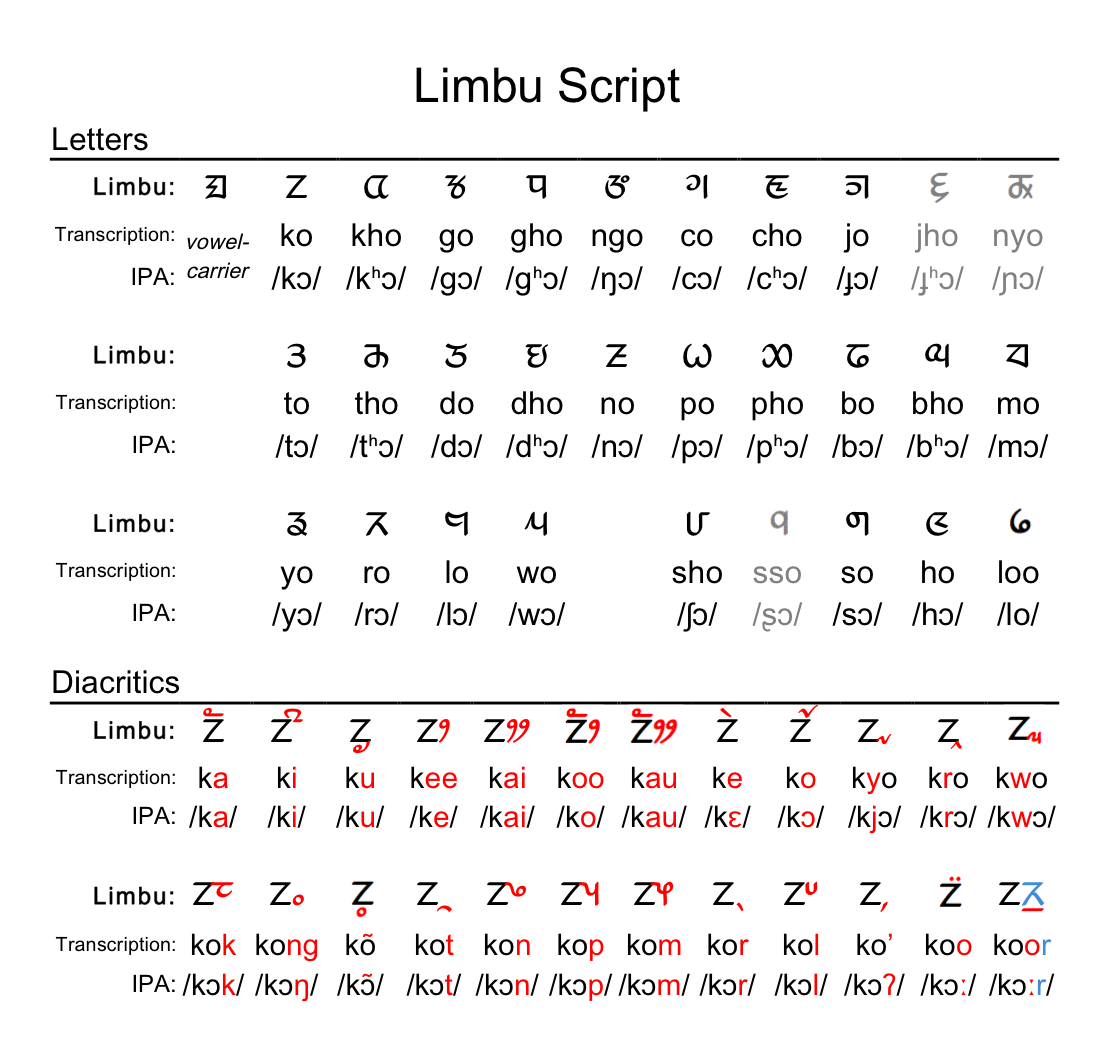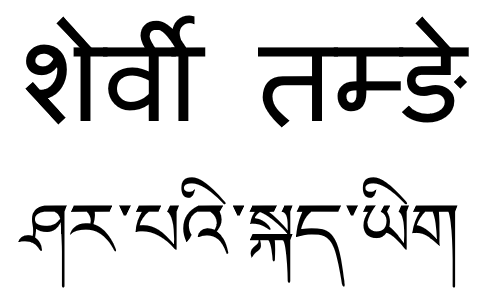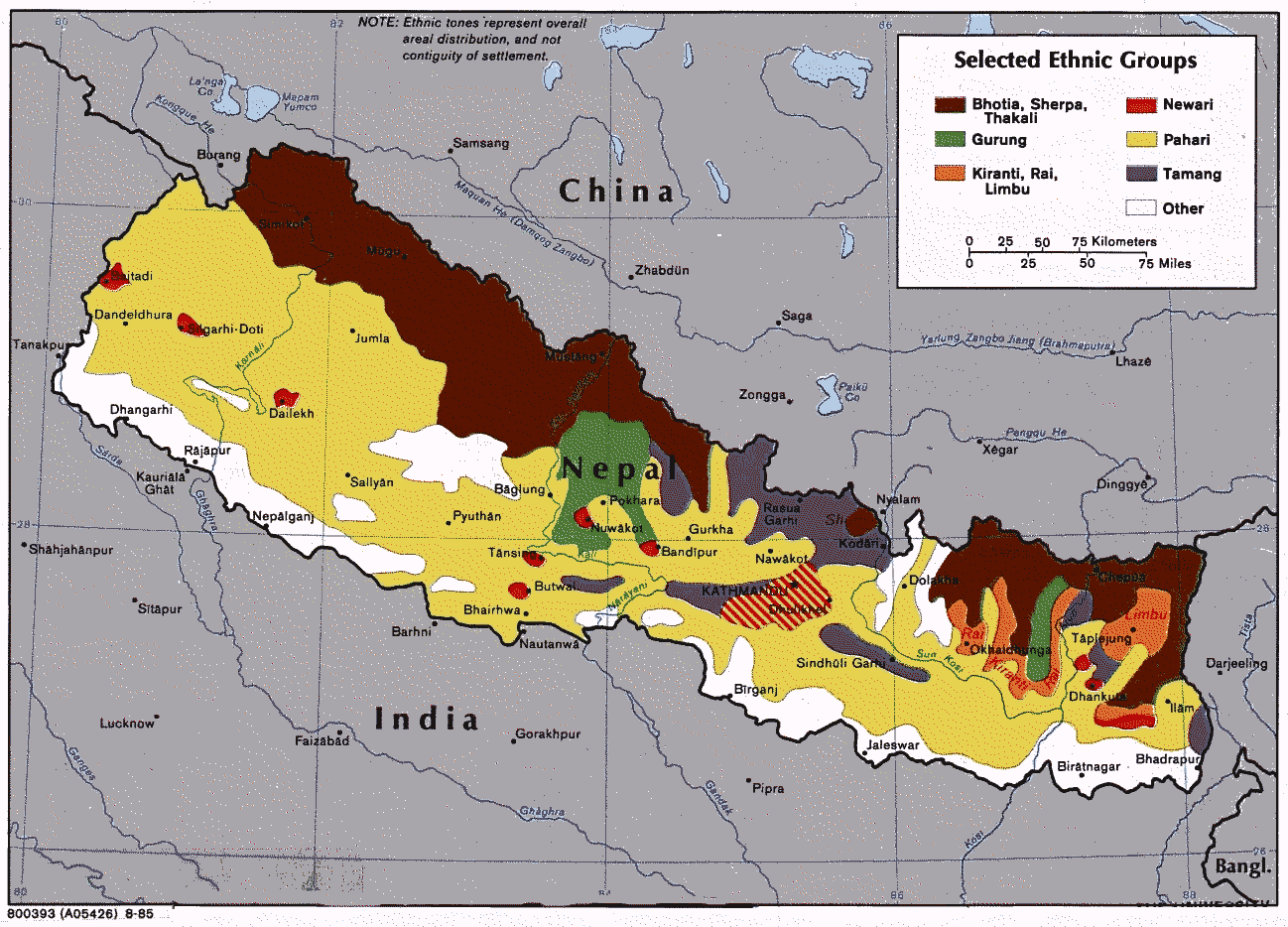|
Chainpur Municipality
Chainpur is a municipality in Sankhuwasabha District in the Koshi Province of north-eastern Nepal. It was formed by merging five villages i.e. Chainpur, Siddhakali, Siddhapokhari, Baneshwar and Kharang. The municipality was implemented on 18 May 2014. At the time of the 1991 Nepal census it had a population of 4933 people in 948 households. Chainpur is an ancient market place of the eastern region of Nepal. It has been famous for hundreds of years for the Karuwa, a special kind of water mug with a pipe tap sculptured with artistic carving on exterior of it. It used to be district headquarters of Sankhuwasabha before it was shifted to Khandbari. Chainpur is famous for making Khukuri. Demographics At the time of the 2011 Nepal census, Chainpur Municipality had a population of 27,462. Of these, 48.4% spoke Nepali, 13.6% Tamang, 10.4% Sherpa, 9.6% Limbu, 3.3% Yakkha, 2.8% Newar, 2.0% Chamling, 1.8% Magar, 1.7% Khaling, 1.6% Rai, 1.4% Thulung, 0.9% Kulung, 0.8% Gurung ... [...More Info...] [...Related Items...] OR: [Wikipedia] [Google] [Baidu] |
Municipality
A municipality is usually a single administrative division having municipal corporation, corporate status and powers of self-government or jurisdiction as granted by national and regional laws to which it is subordinate. The term ''municipality'' may also mean the governing body of a given municipality. A municipality is a general-purpose administrative subdivision, as opposed to a special district (United States), special-purpose district. The English language, English word is derived from French language, French , which in turn derives from the Latin language, Latin , based on the word for social contract (), referring originally to the Latin communities that supplied Rome with troops in exchange for their own incorporation into the Roman state (granting Roman citizenship to the inhabitants) while permitting the communities to retain their own local governments (a limited autonomy). A municipality can be any political jurisdiction (area), jurisdiction, from a sovereign state s ... [...More Info...] [...Related Items...] OR: [Wikipedia] [Google] [Baidu] |
Digital Himalaya
The Digital Himalaya project was established in December 2000 by Mark Turin, Alan Macfarlane, Sara Shneiderman, and Sarah Harrison. The project's principal goal is to collect and preserve historical multimedia materials relating to the Himalaya, such as photographs, recordings, and journals, and make those resources available over the internet and offline, on external storage media. The project team has digitized older ethnographic collections and data sets that were deteriorating in their analogue formats, to protect them from deterioration and make them available and accessible to originating communities in the Himalayan region and a global community of scholars. The project was founded at the Department of Anthropology of the University of Cambridge, moved to Cornell University in 2002 (when a collaboration with the University of Virginia was initiated), and then back to the University of Cambridge in 2005. From 2011 to 2014, the project was jointly hosted between the Unive ... [...More Info...] [...Related Items...] OR: [Wikipedia] [Google] [Baidu] |
Kiranti Languages
The Kiranti languages are a major family of Sino-Tibetan languages spoken in Nepal and India (notably Sikkim, Darjeeling, Kalimpong, and Bhutan) by the Kirati people. External relationships George van Driem had formerly proposed that the Kiranti languages were part of a Mahakiranti family, although specialists are not completely certain of either the existence of a Kiranti subgroup or its precise membership. LaPolla (2003), though, proposes that Kiranti may be part of a larger " Rung" group. Classification There are about two dozen Kiranti languages. Among the better known are Limbu, Sunuwar, Bantawa, Chamling, Khaling, Bahing, Yakkha, Wayu, Dungmali, Lohorung, and Kulung. Kiranti verbs are not easily segmentable, due in large part to the presence of portmanteau morphemes, crowded affix strings, and extensive (and often nonintuitive) allomorphy. Thus their relationship to each other has been a subject of debate. Overall, Kiranti languages are classified: ... [...More Info...] [...Related Items...] OR: [Wikipedia] [Google] [Baidu] |
Khaling Language
Khaling (kʰɛ̂l brâː ख्या:ल् ब्रा:) is a Kiranti language spoken in Solukhumbu district, Nepal and Sikkim, Darjeeling, and Kalimpong in India. It is one of the few Kiranti languages with tonal contrasts, which are of secondary origin. Khaling has approximately 15,000 speakers and is therefore considered a vulnerable language. Khaling has a complex system of stem alternations: as many as 10 distinct stems have to be posited for a word (Jacques et al. 2012). Khaling is very unusual in having an auditory demonstrative (see Jacques and Lahaussois 2014). Khaling is also known as Rai, Khalinge Rai, Khael Bra, and Khael Baat. General information Khaling is still being acquired by children who live in Khaling-speaking areas, as well as non-Khaling children who happen to live in that area. Geographical distribution Khaling is spoken in the following VDC's of Nepal (''Ethnologue''). *Solukhumbu District, Province No. 1: Kanku, Basa, Waku, Buksa, Jubing, Pa ... [...More Info...] [...Related Items...] OR: [Wikipedia] [Google] [Baidu] |
Magar Language
Magar Dhut (, ) is a Sino-Tibetan language spoken mainly in Nepal, southern Bhutan, and in Darjeeling, Assam and Sikkim, India, by the Magar people. It is divided into two groups (Eastern and Western) and further dialect divisions give distinct tribal identity. In Nepal 810,000 people speak the language. While the government of Nepal developed Magar language curricula, as provisioned by the constitution, the teaching materials have never successfully reached Magar schools, where most school instruction is in the Nepali language. It is not unusual for groups with their own language to feel that the "mother-tongue" is an essential part of identity. The Dhut Magar language is sometimes lumped with the Magar Kham language spoken further west in Bheri, Dhaulagiri, and Rapti zones. Although the two languages share many common words, they have major structural differences and are not mutually intelligible. Geographical distribution Western Magar Western Magar (dialects: ''Pal ... [...More Info...] [...Related Items...] OR: [Wikipedia] [Google] [Baidu] |
Chamling Language
Chamling is one of the Kirati languages spoken by the Chamling people, a subgroup of the Kirat (Horsungchha, Dikhalichha, Mulihachha, Ditumachha, Mansungcha, Lipuhochha, Malekungchha, Maidhung, Kherasung, Rakhomi, Bhijaichha, Hodorichha, Yayochha, Pitruchha etc) of Nepal, India and Bhutan. Alternate renderings and names include ''Chamling'', ''Chamlinge'' and ''Rodong''. It is closely related to the Bantawa (some Bantawa-speaking communities call their language "Camling") and Puma languages of the Kiranti language family in eastern Nepal, and it belongs to the broader Sino-Tibetan language family. Chamling has SOV word order. History The Chamling language is one of the languages of the ancient Kiranti culture, which existed well before vedic period 3500–5000 in South Asia. Important versions of the '' Mundum'' — the main religious text forming the religious foundation of the Kirant Mundum religion and the cultural heritage of the various Kirati people — are co ... [...More Info...] [...Related Items...] OR: [Wikipedia] [Google] [Baidu] |
Newar Language
Newar (; , ) is a Sino-Tibetan languages, Sino-Tibetan language spoken by the Newar people, the indigenous inhabitants of Nepal Mandala, which consists of the Kathmandu Valley and surrounding regions in Nepal. The language is known officially in Nepal as Nepal Bhasa, a name that has been historically used for the language. The term "Newari" is also used to refer to the language, although the Indic ''-i'' suffix is considered inappropriate by some Newar speakers. The language served as the official language of Nepal during the Malla dynasty (Nepal), Malla dynasty since the 14th century till the end of dynasty in 1769 during which the language was referred as "Nepal Bhasa", a term which literally means "Nepalese Language". However, the language is not the same as Nepali language, Nepali, an Indo-Aryan languages, Indo-Aryan language and the current official language of Nepal, which only got the name Nepali in the 1930s. Newar literature, Literature in Newar is one of the oldest i ... [...More Info...] [...Related Items...] OR: [Wikipedia] [Google] [Baidu] |
Yakkha Language
Yakkha (also erroneously spelled as Yakha) is a language spoken in parts of Nepal, Darjeeling district and Sikkim. The Yakkha-speaking villages are located to the East of the Arun river, in the southern part of the Sankhuwasabha district and in the northern part of the Dhankuta district of Nepal. About 14,000 people still speak the language, out of 17,003 ethnic Yakkha in Nepal. Genealogically, Yakkha belongs to the Eastern Kiranti languages and is in one subgroup with several Limbu language, Limbu languages, e.g. Belhare language, Belhare, Athpare language, Athpare, Chintang language, Chintang and Chulung language, Chulung. Ethnically however, the Yakkha people perceive themselves as distinct from the other Kiranti groups such as Limbu people, Limbu. Geographical distribution Mugali is spoken between Mugakhola and Sinuwakhola on the eastern banks of the Arun River, China-Nepal, Arun River in Dhankuta District, Province No. 1, Nepal, in the villages (VDC's) of Muga, Nepal, Muga, ... [...More Info...] [...Related Items...] OR: [Wikipedia] [Google] [Baidu] |
Limbu Language
Limbu (Limbu: , ''yakthuṅ pan'') is a Sino-Tibetan language spoken by the Limbu people of Nepal and Northeastern India (particularly West Bengal, Sikkim, Assam and Nagaland) as well as expatriate communities in Bhutan. The Limbu refer to themselves as ''Yakthung'' and their language as ''Yakthungpan.'' Yakthungpan has four main dialects: Phedape, Chhathare, Tambarkhole and Panthare dialects.A Grammar of Limbu By George van Driem 1987 Among four dialects, the Phedape dialect is widely spoken and well understood by most Yakthungpan speakers. However, as there are some dominant Panthare scholars who have role to create knowledge and control knowledge in the Limbu communities, Panthare dialect is being popularised as a "standard" Limbu language. As Panthare Yakthungs are much more engaged in central political position and administrative positions, they are trying to introduce Panthare dialect as a Standard Yakthungpan. Yakthungpan (Limbu language) is one of the major languages ... [...More Info...] [...Related Items...] OR: [Wikipedia] [Google] [Baidu] |
Sherpa Language
Sherpa (also Sharpa, Sherwa, or Xiaerba) is a Tibetic language spoken in Nepal and the Indian state of Sikkim, mainly by the Sherpa. The majority speakers of the Sherpa language live in the Khumbu region of Nepal, spanning from the Chinese (Tibetan) border in the east to the Bhotekosi River in the west. About 127,000 speakers live in Nepal (2021 census), some 16,000 in Sikkim, India (2011), and some 800 in the Tibetan Autonomous Region (1994). Sherpa is a subject-object-verb (SOV) language. Sherpa is predominantly a spoken language, although it is occasionally written using either the Devanagari or Tibetan script. Classification Sherpa belongs to the Tibetic branch of the Tibeto-Burman family. It is closely related to Central Tibetan, Jirel, Humla, Mugom, Dolpo, Lo-ke, Nubri, Tsum, Langtang, Kyirong, Yolmo, Gyalsumdo, Kagate, Lhomi, Walung, and Tokpe Gola. Literary Tibetan ''LT''- becomes /lh/ and ''SR-'' becomes /ʈ/. There are five closely related dialect ... [...More Info...] [...Related Items...] OR: [Wikipedia] [Google] [Baidu] |
Tamang Language
Tamangic language is spoken mainly in Tamangsaling Land in Nepal, Sikkim, West Bengal (Darjeeling) and North-Eastern India. It comprises Eastern Tamang, Northwestern Tamang, Southwestern Tamang, Eastern Gorkha Tamang, and Western Tamang. Lexical similarity between Eastern Tamang (which is regarded as the most prominent) and other Tamang languages varies between 81% and 63%. For comparison, the lexical similarity between Spanish and Portuguese is estimated at 89%. Ethnologue report for Spanish Dialects ''Ethnologue'' divides Tamang into the following varieties due to mutual unintelligibility. *Eastern Tamang: 759,000 in Nepal (2000 WCD). Population total all countries: 773,000. Sub-dialects are as follows. **Outer-Eastern Tamang (Sailung Tamang) **Central-Eastern Tamang (Temal Tamang) **Southwestern Tamang (Kath-Bhotiya, Lama Bhote, Murmi, Rongba, Sain, Tamang Gyoi, Tamang Gyot, Tamang Lengmo, Tamang Tam) *Western Tamang: 323,000 (2000 WCD). Sub-dialects are as follows. ** ... [...More Info...] [...Related Items...] OR: [Wikipedia] [Google] [Baidu] |
Nepali Language
Nepali (; , ), or ''Gorkhali'' is an Indo-Aryan languages, Indo-Aryan language native to the Himalayas region of South Asia. It is the official and most widely spoken Languages of Nepal, language of Nepal, where it also serves as a ''lingua franca''. Nepali has Languages with official status in India, official status in the Indian state of Sikkim and in the Gorkhaland Territorial Administration of West Bengal. It is spoken by about a quarter of Bhutan's population. Nepali also has a significant number of speakers in the Indian states of Arunachal Pradesh, Assam, Himachal Pradesh, Manipur, Meghalaya, Mizoram and Uttarakhand. In Myanmar it is spoken by the Burmese Gurkhas. The Nepali diaspora in the Middle East, Brunei, Australia and worldwide also use the language. Nepali is spoken by approximately 19 million native speakers and another 14 million as a second language. Nepali is commonly classified within the Eastern Pahari group of the Northern Indo-Aryan languages, Northern zo ... [...More Info...] [...Related Items...] OR: [Wikipedia] [Google] [Baidu] |



